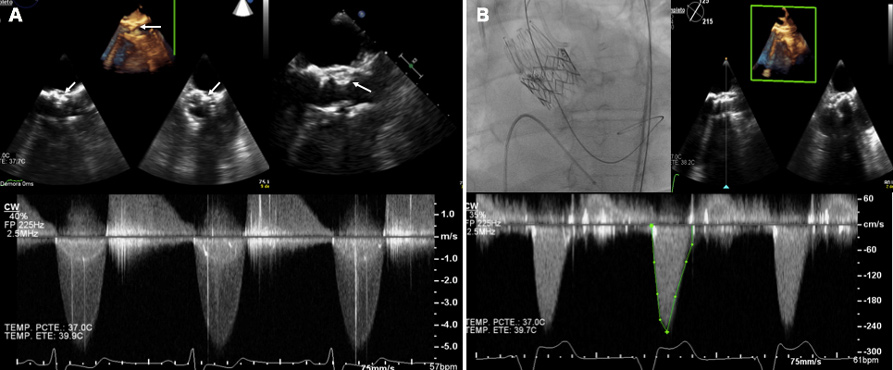03 Aug 2020
A percutaneous solution to transcatheter aortic valve thrombosis refractory to anticoagulation: valve-in-valve implantation of a supra-annular self-expanding transcatheter aortic valve
Supported by the EuroIntervention Journal
Authors
Virginia Pascual-Tejerina1, Raul Moreno1, Francisco J. Dominguez1, Jose Luis Lopez-Sendon1
Case summary
A 56-year-old man with severe aortic stenosis, inoperable left middle cerebral artery bifurcation aneurysm, and Hodgkin lymphoma treated with radiotherapy, underwent transapical transcatheter aortic valve replacement with a 26-mm Sapien XT (Edwards Lifesciences) in 2012. In 2017, the patient was referred for exertion dyspnea, transesophageal echocardiogram (TEE) showed severe stenosis of the bioprosthesis (maximal and mean gradients 87 and 45 mmHg, respectively).
The bioprosthesis showed thin leaflets with a huge thrombus measuring 15x15x15 mm attached to the non-coronary cusp, consistent with bioprosthetic aortic valve thrombosis (Figure-1A, Videos 1-3).

Figure 1
Oral anticoagulation was initiated with antivitamin K and apixaban sequentially with no improvement. A valve-in-valve procedure was planned under TEE-guidance. A 27 mm self-expandable supra-annular Allegra device (NVT) was inserted into the annulus without pre-dilation and without the need of pacing, assessed by fluoroscopy and TEE. Due to moderate paravalvular aortic regurgitation, a post-dilatation with a 26mm balloon was performed.
Afterwards, the proper function and the absence of significant aortic regurgitation were properly checked. (Figure 1B). Planned TTE after procedure showed mean and peak transvalvular gradients of 5 mmHg and 16 mmHg respectively.
Receiving apixaban at discharge, no adverse events were reported at first follow-up control, 30 days after the procedure.
In conclusion, the presented case is -to the best of our knowledge- the first transcatheter aortic valve thrombosis treated with a trans-catheter aortic valve-in-valve technique, which seems to be an appealing new therapeutic approach of this potential complication after trans-catheter aortic valve procedures. Undoubtedly, further experience is needed for this promising indication.
Conflict of interest statement
Raul Moreno is a proctor of NVT. The other authors have nothing to disclose.
Affiliations
- Department of Cardiology. La Paz University Hospital. Madrid, Spain.
Reference
- Huchet F, Letocart V, Guerin P, Cueff C, Roy-Giocosa J, Guyomarch-Delasalle B, Jaafar P, Manigold T. Could anticoagulation avoid bioprosthesis subclinical thrombosis in patients undergoing transcatheter aortic valve replacement Arch Cardiovasc Dis. 2018;111:25-32.






3 comments
Thanks for sharing this nice case . The case is very high risk for embolization during manipulation of the thrombotic valve, did you use protection device?
What happened to the large thrombus?
well done no new comment